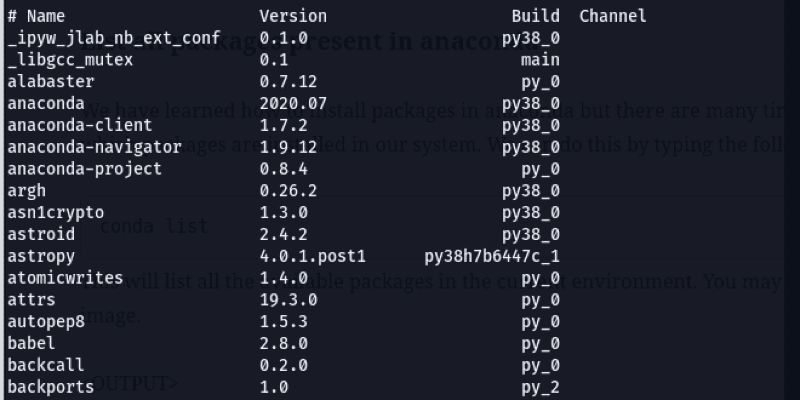For this reason, developers often create a virtual environment for a project. A virtual environment is a subfolder in a project that contains a copy of a specific interpreter. When you activate the virtual environment, any packages you install are installed only in that environment's subfolder.
When you then run a Python program within that environment, you know that it's running against only those specific packages. Conda is an open source package manager similar to pip that makes installing packages and their dependencies easier. Unlike pip, conda is also an environment manager similar to virtualenv.
Package managers are especially helpful in high-performance computer settings, because they allow users to install packages and their dependencies locally with just one command. After running this command, you will notice that a new file named Pipfile was created in your-folder. A Pipfile contains package information that represents a python environment.
Open your terminal and make sure you are still in the your-folder directory; then, run pipenv shell. You have now activated your python environment, the environment that contains the arcgis package! You can run jupyter notebook or python in this environment to start using the API. A conda environment is a Python environment that's managed using the conda package manager (see Getting started with conda (conda.io)). Conda works well to create environments with interrelated dependencies as well as binary packages. Unlike virtual environments, which are scoped to a project, conda environments are available globally on any given computer.
This availability makes it easy to configure several distinct conda environments and then choose the appropriate one for any given project. The conda init command places code in your .bashrc file that modifies, among other things, the PATH environment variable by prepending it to the path of the base conda environment. This occurs before the default system modules are loaded. Pip accesses the Python Package Index, PyPI , which stores almost 200,000 projects and all previous releases of said projects. Because the repository keeps previous versions, you can pin to a version and not worry about updates causing conflicts.
Pip can also install packages in local virtualenv, or virtual environment. By default, any Python interpreter that you've installed runs in its own global environment, which is not specific to any one project. For example, if you just run python or python3 (macOS/Linux) at a new command prompt, you're running in that interpreter's global environment. Accordingly, any packages that you install or uninstall affect the global environment and all programs that you run within that context.
Anaconda is a package manager, an environment manager, and Python distribution that contains a collection of many open source packages (numpy, scikit-learn, scipy, pandas to name a few). If you need additional packages after installing Anaconda, you can use Anaconda's package manager, conda or pip to install those packages. This is highly advantageous as you don't have to manage dependencies between multiple packages yourself. Conda even makes it easy to switch between Python 2 and 3 . In fact, an installation of Anaconda is also a common way to install Jupyter Notebooks. These were the different ways to add packages to Anaconda environment.
Anaconda already has the most frequently used packages installed. But as you progress towards data science and machine learning, you will have to install more packages. See anaconda.com/blog/using-pip-in-a-conda-environment for more information. To run Python conveniently from a command prompt, you might consider changing some default environment variables in Windows. While the installer provides an option to configure the PATH and PATHEXT variables for you, this is only reliable for a single, system-wide installation.
If you regularly use multiple versions of Python, consider using the Python Launcher for Windows. This will add the path to the Python interpreter from the new virtual environment to your workspace settings. That environment will then be used when installing packages and running code through the Python extension. For examples of using virtual environment in projects, see the Python, Django, and Flask tutorials. While the error in the image occurred when installing a library after installing anaconda, keep in mind it is possible to have this sort of error when installing anaconda .
If you had this error and you want to install libraries, please open your command prompt/anaconda prompt or anaconda navigatoras administratorto install your packages. More recent Anaconda distributions will tell you to use the command conda activate instead of source activate to activate your newly created environment. If you use conda activate, you will be prompted to issue the command conda init. When you load one of our Anaconda modules, you have effectively loaded the base conda environment for that Anaconda version. However, conda tries to manage activation of its own base environment by modifying the user's .bashrc file. We will also learn what a package manager is and how to install packages using pip and conda.
Lastly, we will install the Jupyter Notebook package so we can create and share interactive Python notebooks. Cloudera Machine Learning recommends using pip for package management along with a requirements.txt file . However, for users that prefer Conda, the default engine in Cloudera Machine Learning includes two environments called python2.7, and python3.6. These environments are added to sys.path, depending on the version of Python selected when you launch a new session. We provide GPU versions of various frameworks such as tensorflow, keras, theano, via modules. However, sometimes you may need additional libraries or packages that are not available as part of these modules.
In this case, you will need to create your own GPU Anaconda environment. Methods differ in ease of use, coverage, maintenance of old versions, system-wide versus local environment use, and control. With pip or Anaconda's conda, you can control the package versions for a specific project to prevent conflicts. Conda also controls non-Python packages, like MKL or HDF5.
System package managers, like apt-get, install across the entire computer, often have older versions, and don't have as many available versions. Source compilation is much more difficult but is necessary for debugging and development. If you don't know which installation method you need or prefer, we recommend the Scientific Python Distribution Anaconda.
In this tutorial, we will see different ways to add packages to the Anaconda environment in Python. It is widely used for the ease of package management and deployment. It has data-science packages for all major OS platforms. To manage packages, Anaconda provides "conda" as the package manager which is equivalent to "pip" in Python. Begin by following instructions above to create virtual environment.
Install your desired package prior to starting jupyter notebook. PyCharm provides methods for installing, uninstalling, and upgrading Python packages for a particular Python interpreter. By default, PyCharm uses pip to manage project packages. For Conda environments you can use the conda package manager. Included in all versions of Anaconda, Conda is the package and environment manager that installs, runs, and updates packages and their dependencies.
Now that we have a Python distribution installed and were able to run some Python code, let's install the Jupyter Notebook package. Jupyter Notebook is an open-source web application that allows us to create and share documents that contain live code, equations, visualizations and narrative text. This is a fantastic way to both learn and share Python code and the installation is made easier by our package installer! The installation steps differ depending on which Python distribution we installed above, so be sure to jump to the appropriate section.
If you have both pip and Miniconda installed, we recommend using Miniconda to install the Jupyter Notebook package. Note the default installation prefix is set to the system path where OSC users cannot install the package. With the option --user, the prefix is set to $HOME/.localwhere lib, bin, and other top-level folders for the installed packages are placed.
Finally, the option --upgradewill upgrade the existing packages to the newest available version. While our Python installations come with many popular packages installed, you may come upon a case in which you need an additional package that is not installed. If the specific package you are looking for is available from anaconda.org (formerlly binstar.org), you can easily install it and required dependencies by using the conda package manager. Alternatively, HyperSpy can be installed in an existing python distribution, read the conda installation andpip installation sections for instructions.
Third-party packages should be installed by the application installer alongside the embedded distribution. There are several methods that enable us to install Python packages. As previously mentioned, in this post we will learn how to install Python packages using pip, conda package manager, and Anaconda Navigator. Note, if using conda package manager or Anaconda Navigator we need to have the Python distribution Anaconda installed.
Anaconda, from Anaconda, Incis a completely free enterprise-ready distribution for large-scale data processing, predictive analytics, and scientific computing. It includes over 195 of the most popular Python packages for science, math, engineering, and data analysis. Anaconda includes the condapackage and environment manager to make managing these environments straightforward.
It is preferred that you use the Anaconda prompt installed with Anaconda. All you have to do is create a virtual environment inside Anaconda and activate the environment. These commands can be run in the Anaconda prompt irrespective of Windows or Linux machine.
Previously in this chapter, you learned about conda environments and the difference between conda and pip. On this page, you will learn how to create and work with conda environments. You will also learn how to install Python packages using the conda-forge channel.
I am trying to install packages from pip to a fresh environment created using anaconda. This downloads the conda packages as a conda environment in their local directories. From there, they can activate the environment and start running their analyses. Create a new virtual environment and install packages that you want to be used in other projects. Then you can specify this virtual environment as a Python interpreter for the target project and all the needed packages will be available.
You can create new Conda environments in one of your available directories. Conda environments are isolated project environments designed to manage distinct package requirements and dependencies for different projects. You can use the conda command, with various options, to install and inspect Conda environments. However, we recommend using the mamba command instead for faster package solving, downloading, and installing. Python modules are based on Anaconda package manager, and miniconda3 module is based on Miniconda package manager.
Python modules are typically recommended when you use Python in a standard environment that we provide. However, if you want to create your own python environment, we recommend using miniconda3 module, since you can start with minimal configurations. Of course, installing Python packages, using conda, in an environment is not any different than using conda to install Python packages in the base environment. Once you have activated a conda environment, all installations that you run will be installed specifically to this environment. This allow you to have ultimate control when installing and managing dependencies for each project.
To install the API with no dependencies, simply add the --no-deps flag to any install command, i.e. conda install -c esri arcgis --no-deps or pip install arcgis --no-deps. You can then manually choose which dependencies to add to your Python environment. Miniconda on the other hand, is a slimmed down version of Anaconda and includes all of the same components except for the pre-installed 1,500 data science packages. Instead, we can simply install these packages individually as needed using conda (the Anaconda/Miniconda package manager). We essentially get all the benefits of Anaconda, but without the hassle and burden of the large size.
Feel free to use either distribution, however Miniconda is probably the better choice for getting set up with the least amount of fuss. Pip installs all package dependencies, regardless of whether they conflict with other packages already installed. To avoid dependency conflicts, pip uses tools such as virtualenv and venv to create isolated environments. The Microsoft Store package is a simple installation of Python that is suitable for running scripts and packages, and using IDLE or other development environments.
It requires Windows 10, but can be safely installed without corrupting other programs. It also provides many convenient commands for launching Python and its tools. Unlike most Unix systems and services, Windows does not include a system supported installation of Python. To make Python available, the CPython team has compiled Windows installers with every release for many years. These installers are primarily intended to add a per-user installation of Python, with the core interpreter and library being used by a single user. The installer is also able to install for all users of a single machine, and a separate ZIP file is available for application-local distributions.
You can install additional libraries and packages from the workbench, using either the command prompt or the terminal. Alternatively, you might choose to use a package manager such as Conda to install and maintain packages and their dependencies. This topic describes some basic usage guidelines for Conda. In this section, we are going to learn how to update Python packages using pip and conda. This comes in handy as sometimes packages are updated by the users who created them. Updating packages can sometimes make changes to both the package and also to how your code runs.
Before we update a Python package, we need to make sure we know what any changes are new and how potentially may affect our code. That is, if we have a lot of Python code, upgrading a Python package may completely change the behavior, or functionality, of our code. Pip is a standard package-management system that we can use to install and manage software packages written in Python. A lot of the Python packages can be found in the default source for packages and their dependencies — Python Package Index .



























No comments:
Post a Comment
Note: Only a member of this blog may post a comment.